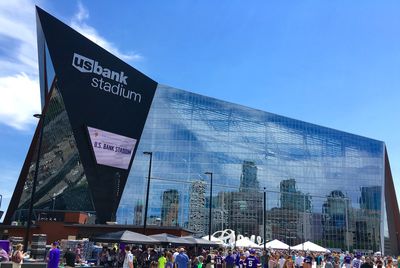In November, AT&T shared its plans to launch its "5G Evolution" network -- which isn't true 5G -- in select areas of Minneapolis as part of its overall plan to boost cellular coverage in the city during Super Bowl LII. This week, three of the major United States cellular carriers -- AT&T, Verizon, and T-Mobile -- each outlined their own plans to ensure that customers retain quality coverage in the Twin Cities on the weekend of February 4.

AT&T said its users can expect "a better mobile experience" in the city, with technology it's been working on for over a year that combines both permanent and temporary upgrades to the carrier's cellular connectivity. The company's $40 million investment in its Minneapolis wireless network boost includes coverage within the U.S. Bank Stadium (where the game will take place), as well as outside the stadium in hotels, airports, and other venues that will see increased traffic in a few weeks.
AT&T's upgrades:
- Upgraded in-stadium Distributed Antenna System (DAS) offering "nearly 220% more LTE capacity."
- More than 800 hidden antennas in the stadium to help manage wireless traffic.
- DAS installed at 16 total locations in Minneapolis.
- 10 Cell on Wheels (COWs, or temporary towers) deployed to further support reliability of AT&T's network.
- 5G Evolution with 256 QAM, 4x4 MIMO, and 3-way carrier aggregation in select areas on supported smartphones.
Verizon predicted a "blizzard" of data usage for the Super Bowl this year, and said it's been working for two years on preparing the Minneapolis-Saint Paul area for the event. Verizon focused on its more permanent updates, which include boosted performance in the U.S. Bank Stadium and other venues throughout the Twin Cities area.
Verizon's upgrades:
- 24 new permanent cell sites and more than 230 permanent small cell sites.
- Introduction of LTE Advanced features to 4G LTE network "for greater capacity and faster peak data speeds."
- Addition of 48 percent more antennas to DAS inside stadium.
- New neural host DAS in Mall of America to boost network capacity by 900 percent.
- Similar system added to Minneapolis-Saint Paul International Airport to boost network capacity by more than 1,000 percent.
T-Mobile laid out similar upgrades it's been working on for the last two years, which it said make its LTE network "the fastest in the Twin Cities." Those on T-Mobile's network can expect boosted network capacity in the U.S. Bank Stadium, the Minneapolis Convention Center, Xcel Energy Center, and locations like the Armory, Nicollet Mall, downtown St. Paul, Mall of America, and the International Airport.
T-Mobile's upgrades:
- Boosting network capacity 30x in U.S. Bank Stadium, 35x in the convention center, and 16x in Xcel Energy Center.
- Doubling the amount of LTE spectrum in the Twin Cities, along with carrier aggregation, 256 QAM, and 4x4 MIMO.
- Deploying more than 120 small cells across Minneapolis and surrounding areas.
- Increasing upload speeds up to 40 percent inside the stadium with Centralized Radio Access Network (C-RAN) technology.
Sprint's news on boosted Super Bowl network coverage came in a press release last month. Sprint users will get much of the same bonuses as the other carriers, with the company installing a DAS with 800 antennas inside the stadium, as well as small cells installed on lamp posts and street lights throughout Minneapolis. There will also be the "Sprint Magic Box," which Sprint described as the "world's first all-wireless small cell" to be placed in hundreds of locations across the Twin Cities to boost indoor data speeds by an average of 200 percent.
Although it won't launch in time for Super Bowl LII, T-Mobile has also provided more details on its own plans for a true 5G network, while commenting on AT&T's "#Fake5G" debut in 2017. T-Mobile said its schedule for 5G hasn't changed, and is still on track to debut nationwide by 2020. The company said it's been "encouraged" by confirmed chipset and OEM plans to launch wider support for 5G smartphones in 2019, which will initiate broad support for a "real 5G" network.
























Top Rated Comments
Go to a Thunder game or a concert at the OKC or Tulsa arena (18-20k people) and it's barely better, plain texts and calls go out, but no data coverage.
-AT&T, Verizon, and T-Mobile
/picks teeth
/walks away